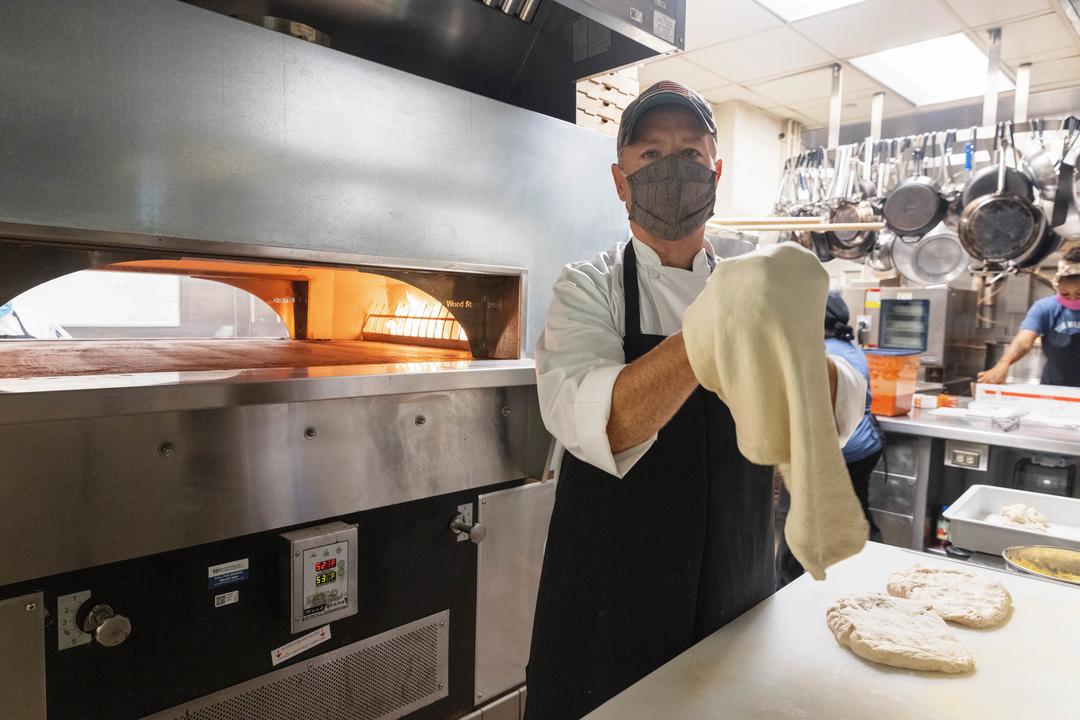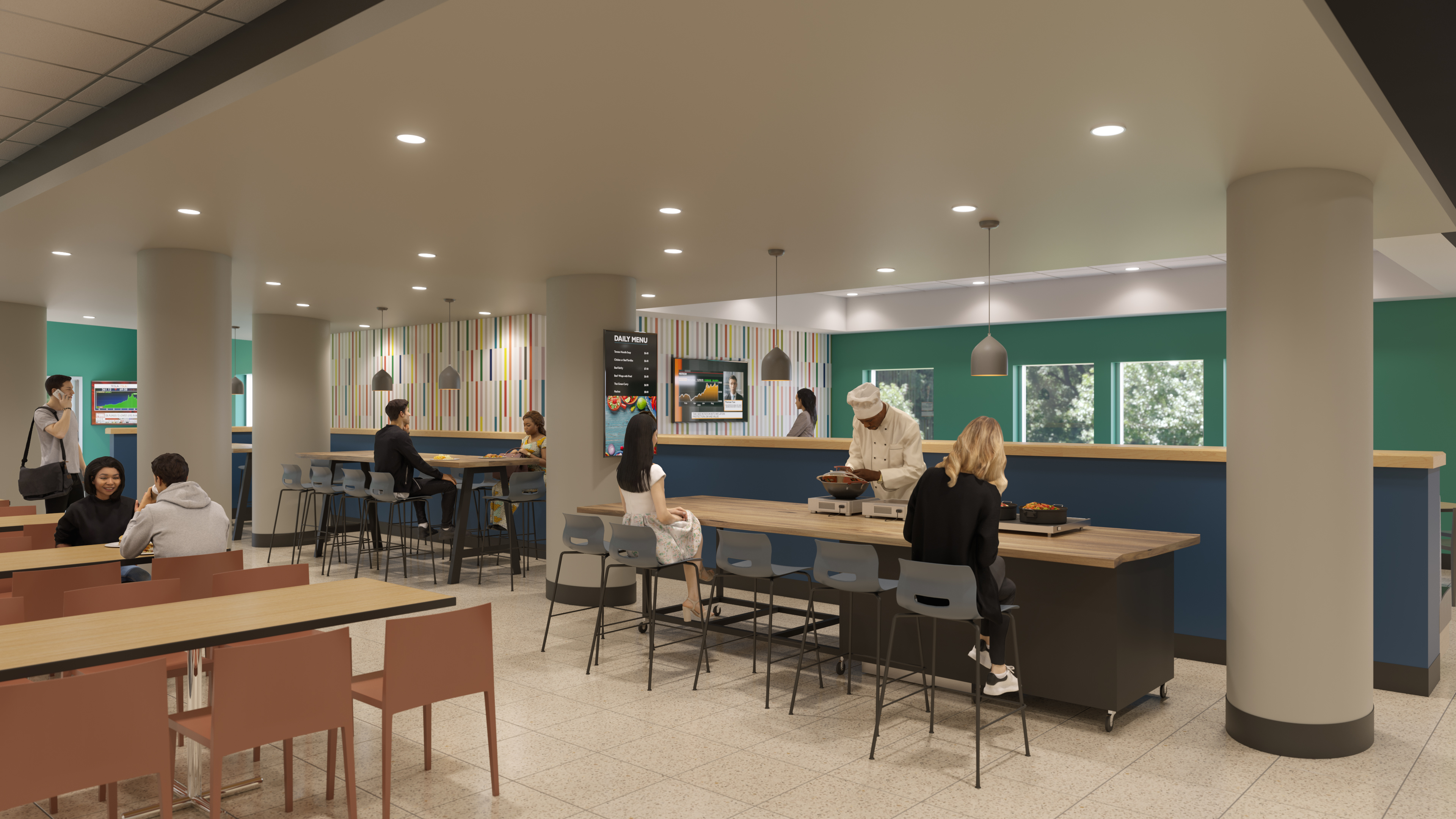Nearly two months after introducing students to the George Washington University’s enhanced dining experience, The Eatery at Pelham Commons offers students a renewed focus on community, sustainability, affordability, choice and quality. The vision for the dining space was a collaboration between the university and Chartwells Higher Education, with the culinary program spearheaded by Chef Richard Hetzler. According to Mr. Hetzler, students have responded well to the opening and are enjoying the innovative dining options such as the teaching kitchen the sliced-to-order carving station as well as the made-to-order station through the newly implemented technology system.
There are five distinct dining stations within Pelham Commons. Each offers students the option to customize their meals including Create, which focuses on made-to-order salads and sandwiches; and Innovation, a chef-attended made-to-order station. In addition, culinary staff is available to answer questions on topics ranging from nutrition and allergies to the history of the food. Vegan and vegetarian options are available at every meal, and a white board near the front of The Eatery lists where the fresh ingredients are from, usually farms in the D.C. metropolitan area.
The changes at Pelham Commons are a prelude to what is to come on the Foggy Bottom campus. Expected in fall 2022, Thurston Hall will open a 225-seat dining hall, and the food court areas of Shenkman Hall and District House will be turned into residential dining halls. The Chick-Fil-A will move to the University Student Center.
In fall 2023, the on-campus dining experience will expand further into retail options, convenient grab and go destinations and a marketplace will open in the University Student Center.
Mr. Hetzler, the district chef at Chartwells Higher Education Dining Services overseeing much of the transformation of GW’s dining experience, answered questions for GW Today about his biggest takeaways so far:
Q: How are things going a few months into this reimagined space at Pelham Commons?
A: So far, things are going well. The student feedback has been phenomenal. We're really just trying to be different than your typical dining hall. And that’s why we’re changing stations and constantly looking at the food program to keep things fun, exciting and energetic for the students.
Q: You are serving students living on their own and choosing their own culinary options for the first time. What are some ways this new plan is helping them build healthy, sustainable eating habits?
A: Sustainability is at the forefront for us and what we do as a company. We choose how we source our food, and then, even to the aspect of how we prepare it—you really do not add anything to it, we want to keep it as true and flavorful as it already is. We do a lot of nutritional labeling. Students can also pull up our databases on their phones to look at recipes, additional content, different allergies that go along with it without having the comfort of it being a home cooked meal with things that parents had taken care of. So, we give them all of that, and then we have experts on hand—chefs, house supervisors or managers—to answer any questions that might come up.
Q: What are some of the most popular menu items so far? What trends have you noticed in students eating at the dining hall?
A: We’ve done a couple of Mac and Cheese bars, and those are popular. Also, wings, tenders and some of the traditional food you think of. But other ones, like poutine, is something that, unless you’re from that area, people might see but don’t necessarily know. Those have been some of the one-offs where people come in and say “Wow, pretty amazing!” Also, our create station really walks them through how they can customize a meal to what they’re looking for on that particular day.
Q: How do culture and food intertwine? What are some ways GW is incorporating this in its new dining plan?
A: That’s what food is. Food is culture. It just goes to the forefront of who we are as human beings where you can tell the amount of love that somebody has for something in what they produce every day when it comes to foods. Let the food sell itself and be the food it is supposed to be. Looking at those traditional flavors and how you blend them and not overemphasize them. If we want it to be an empanada, we want it to be a true empanada. If we’re going to do a pizza, it’s going to be a fresh dough pizza where we take San Marzano tomatoes and basil, salt, pepper and our sauce. We’re not going to use tomato paste on the pizza. We are taking the best ingredients, showcasing those ingredients and then letting everybody judge that food as it stands.
Q: Is there anything else you would like to add?
A: I can’t tell you how happy we are to be here at George Washington University. We’re looking at tremendous growth over the next year and are really excited to take this program here and use it as an incubator to grow what we're going to be doing at Foggy Bottom. For anybody that's had time to dine with us, wait until next fall because you're really going to get to see a lot more supersonic meals coming out of the kitchen to really get to taste some awesome food.



